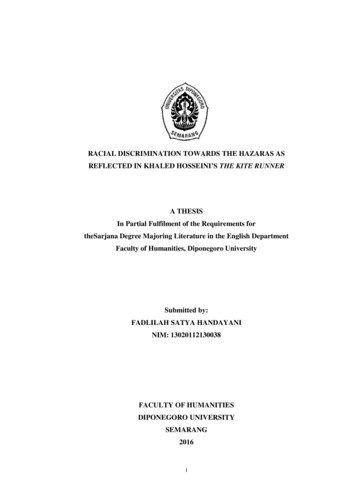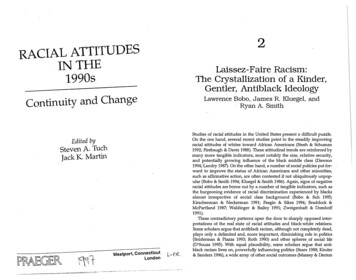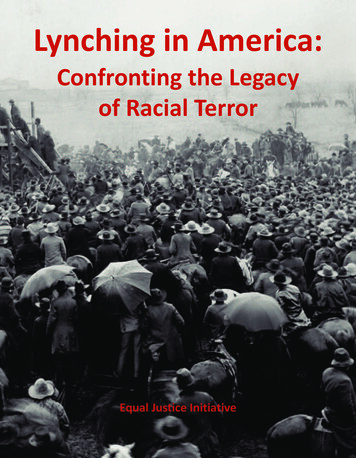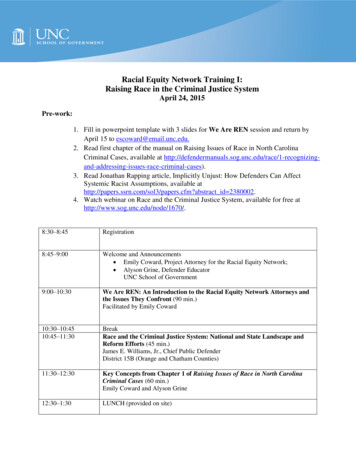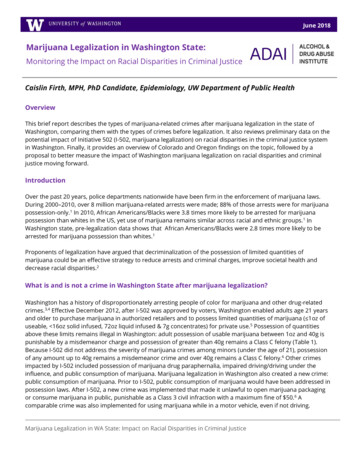
Transcription
June 2018Marijuana Legalization in Washington State:Monitoring the Impact on Racial Disparities in Criminal JusticeCaislin Firth, MPH, PhD Candidate, Epidemiology, UW Department of Public HealthOverviewThis brief report describes the types of marijuana-related crimes after marijuana legalization in the state ofWashington, comparing them with the types of crimes before legalization. It also reviews preliminary data on thepotential impact of Initiative 502 (I-502, marijuana legalization) on racial disparities in the criminal justice systemin Washington. Finally, it provides an overview of Colorado and Oregon findings on the topic, followed by aproposal to better measure the impact of Washington marijuana legalization on racial disparities and criminaljustice moving forward.IntroductionOver the past 20 years, police departments nationwide have been firm in the enforcement of marijuana laws.During 2000–2010, over 8 million marijuana-related arrests were made; 88% of those arrests were for marijuanapossession-only.1 In 2010, African Americans/Blacks were 3.8 times more likely to be arrested for marijuanapossession than whites in the US, yet use of marijuana remains similar across racial and ethnic groups.1 InWashington state, pre-legalization data shows that African Americans/Blacks were 2.8 times more likely to bearrested for marijuana possession than whites.1Proponents of legalization have argued that decriminalization of the possession of limited quantities ofmarijuana could be an effective strategy to reduce arrests and criminal charges, improve societal health anddecrease racial disparities.2What is and is not a crime in Washington State after marijuana legalization?Washington has a history of disproportionately arresting people of color for marijuana and other drug-relatedcrimes.3,4 Effective December 2012, after I-502 was approved by voters, Washington enabled adults age 21 yearsand older to purchase marijuana in authorized retailers and to possess limited quantities of marijuana ( 1oz ofuseable, 16oz solid infused, 72oz liquid infused & 7g concentrates) for private use.5 Possession of quantitiesabove these limits remains illegal in Washington: adult possession of usable marijuana between 1oz and 40g ispunishable by a misdemeanor charge and possession of greater than 40g remains a Class C felony (Table 1).Because I-502 did not address the severity of marijuana crimes among minors (under the age of 21), possessionof any amount up to 40g remains a misdemeanor crime and over 40g remains a Class C felony.6 Other crimesimpacted by I-502 included possession of marijuana drug paraphernalia, impaired driving/driving under theinfluence, and public consumption of marijuana. Marijuana legalization in Washington also created a new crime:public consumption of marijuana. Prior to I-502, public consumption of marijuana would have been addressed inpossession laws. After I-502, a new crime was implemented that made it unlawful to open marijuana packagingor consume marijuana in public, punishable as a Class 3 civil infraction with a maximum fine of 50.6 Acomparable crime was also implemented for using marijuana while in a motor vehicle, even if not driving.Marijuana Legalization in WA State: Impact on Racial Disparities in Criminal Justice
Table 1. Washington State Marijuana-Related Criminal Offenses Before and After I-502Source: Darnell A, Bitney K. I-502 Evaluation and Benefit-Cost Analysis: Second Required ReportTechnical Appendix. Olympia: Washington State Institute for Public Policy, 2017.Marijuana Legalization in WA State: Impact on Racial Disparities in Criminal Justice2 Page
Marijuana Legalization and Criminal Justice Studies: Statewide, Local, and Beyond WashingtonWashington StateTo date, the evaluation of I-502 on criminal justice outcomes has focused on changes in the number of arrestsand criminal charges related to marijuana crimes; studies examining racial disparities after legalization inWashington are still preliminary. The studies that utilize data routinely collected across the state of Washingtonare summarized below:Washington State American Civil Liberties Union. After legalization, the ACLU of Washington requesteddemographic data from the Association of the Courts (AOC) to assess differences in rates of misdemeanorpossession of marijuana court filings by racial group before and after legalization (2009–2013) among adults 21 years.7 Currently, this assessment of marijuana crime by race in Washington is the only published report of itskind. Prior to legalization, the number of marijuana possession filings among adults 21 years was decreasingfrom 7,964 in 2009 to 5,531 in 2012, and after legalization the number of filings dropped in 120 in 2013. During2012, the rate of court filings among African Americans/Blacks was 2.7 times that of whites and a year later, thedisparity remained the same. The data suggested that the disparity in court filings persisted after legalization.However, it is unclear when the initial offense and arrest occurred. Because decriminalization of marijuanapossession began in December of 2012, it is possible that court cases filed in 2013 were of arrests that occurredprior to marijuana legalization. Therefore, it is imperative to continue to monitor marijuana-related crimes andconvictions by racial groups to elucidate any effects of legalization on racial disparities over time in the criminaljustice system.Washington State Office of Financial Management. The Washington State Office of Financial Management (OFM)reported characteristics of marijuana-related incidents and arrests over time as part of their series to monitorimpacts of I-502.8 The OFM used data reported to the Washington Association of Sheriffs and Police Chiefs(WASPC) by law enforcement agencies to describe the number of marijuana incidents and arrests over time. Asthe FBI define it, an incident occurs when any law enforcement investigates a scenario, whether it results in anarrest or not.9 Incidents included in the OFM report were scenarios in which marijuana was listed as the first oronly suspected illicit drug. Since legalization, the number of marijuana incidents has dropped by 58-63% amongall ages. Proportionately, the distribution of marijuana incidents by crime type has remained relatively the same.Possession still accounts for nearly 90% of marijuana incidents (Table 2). This finding seems logical given thatOFM included offenders under the age of 21, and possession of any quantity of marijuana remained amisdemeanor penalty. Unfortunately, trends specific to demographic groups were not reported in this analysis.Table 2. Marijuana incidents in Washington by crime type, 2012–201520126336201326892014232620152313Total Count of OffensesOffenses by Crime TypePossession or Consumption 5786 (91%) 2373 (88%) 2103 (90%) 1999 (86%)Distribution or Selling327 (5%)194 (7%)126 (5%)198 (9%)Cultivating or Manufacturing127 (2%)84 (3%)62 (3%)47 (2%)Source: Forecasting and Research Division, Washington State Office of Financial Management. Monitoring Impacts ofRecreational Marijuana Legalization: 2016 Update Report. Olympia; 2017.Marijuana Legalization in WA State: Impact on Racial Disparities in Criminal Justice3 Page
Washington State Institute for Public Policy. WSIPP conducted a comprehensive legislatively-mandated evaluationand benefit-cost analysis of I-502 that included the impacts on convicted criminal charges.10 The study assessedchanges in the rate of convictions over time, the effect of legal cannabis sales, and differences in the effects oflegalization by age group (adults 21 years vs. under 21 years). The only drug-related convictions specific tomarijuana that changed was misdemeanor possession of marijuana. As expected, the number of convictionsamong adults 21 years of age dropped to 0 and misdemeanor charges for paraphernalia dropped substantiallyafter legalization. Neither marijuana nor paraphernalia possession convictions were affected by the amount ofcannabis sales within the corresponding Washington county. For people convicted under the age of 21,misdemeanor possession of marijuana did decline after legalization from 1,015 in the first quarter of 2012 to 722in the first quarter of 2013, but as with adults, the amount of cannabis sales did not have a significant effect on[was not correlated with / was not related to] drug conviction rates.Preliminary look at racial disparities in select counties of WashingtonThe Crime, Cannabis & Police Research Group at Washington State University used preliminary data from aDepartment of Justice funded study to compare white vs. Black arrests.11 Latinos were not included in theanalysis, because of difficulties measuring ethnicity in arrest data. Their main preliminary findings are that afterlegalization in Washington, African Americans/Blacks continue to be disproportionally arrested for thepossession and selling of marijuana when compared to whites. Though the disparity in marijuana possessionbetween African American/Blacks and whites was reduced slightly after legalization, the disparity for sellingmarijuana has more than doubled since legalization.Local trendsWhile statewide studies have the ability to control for individual law enforcement agencies or policedepartments, monitoring trends in marijuana-related crimes within a local police department can provide detailsof violations that statewide data systems do not. For example, violations for public consumption of marijuanacannot be directly queried from state-derived data; however, local law enforcement agencies and municipalcourts maintain details on the nature of the crime that would indicate whether someone was ticketed for publicconsumption vs. possession or a different drug-related charge. One example of the potential of local data toexplore issues of criminal justice can be made using data from the Seattle Police Department (SPD). A 2015report for the Seattle Community Police Commission showed a disproportionate number of citations formarijuana public consumption issued to African Americans/Blacks in Seattle.12 Using local police departmentdata is key to understanding differences in the implementation and enforcement of polices pertaining to thelegalization of marijuana.Beyond Washington StateCompelling evidence in other states suggest racial disparities persist or have become worse after legalizationand the opening of a licensed marijuana market, even while total marijuana-related criminal justice incidentshave decreased.In Colorado, marijuana court filings decreased by 85% from 2010 to 2014 after legalizing marijuana in 2012.During the same time frame the rate of arrests for marijuana possession among African Americans/Blacksremained 2.4 times higher compared to the arrest rate for whites. The disparities for African American/Blackswere even larger for arrests for marijuana cultivation (2.5 times the arrest rate for whites) and distribution ofmarijuana (5.4 times the arrest rate for whites).13Results from Oregon are consistent with findings in Colorado. The Oregon Public Health Division examinedchanges in the age-adjusted rates of marijuana arrests by racial groups.14 The age-adjusted rate of marijuanaMarijuana Legalization in WA State: Impact on Racial Disparities in Criminal Justice4 Page
arrests for African Americans/Blacks was 2 to 3 times the rate of whites during 2010–2014. Oregon legalizedmarijuana in 2014 and in the following year the disparity between African Americans/Blacks and whitespersisted. Specifically, the rate of arrest was 77% higher among African Americans/Blacks in 2015 whencompared to whites.Preliminary results suggest that legalization of marijuana for adults has greatly reduced the number of peoplearrested and convicted for marijuana-related crimes, yet racial disparities persist in Washington and in otherstates. Other factors may contribute to sustaining the racial disparities, such as over-policing in low-incomeneighborhoods, racial profiling, and other racially biased police practices. 15 These inequitable practices mayminimize the potential positive impacts of I-502 and marijuana legalization on all communities.Areas for Future ResearchWhat to measureAssessment of the impact of I-502 on criminal justice and racial disparities is still in its early stages. In order tomeasure the impacts of I-502 and local marijuana regulatory policies on criminal justice, it is imperative toconsider both direct and indirect consequences of legalization. Initiative 502 directly addressed changes incriminal law around marijuana possession, consumption, paraphernalia and driving under the influence.Below are suggested measures for assessing the direct and indirect effects of I-502 on criminal justice andracial/ethnic disparities, building on the recommendations put forth by Washington State Institute for PublicPolicy.10 The rationale for measuring each indirect effect of I-502 is stated in italics. This list is by no meansexhaustive and is meant as a starting place to monitor trends and assess the equitable impacts of legalizationacross communities—particularly communities of color that have been disproportionately affected by marijuanaprohibition.Aspects directly addressed in I-502 statutory changes, include: Changes in marijuana-related offenses and arrests after I-502 by race/ethnicity & age group (adults 21 years vs. 21 years). Changes in misdemeanor marijuana-related convictions after I-502 by race/ethnicity & age group. Changes in drug-related DUI convictions & misdemeanor paraphernalia convictions after I-502 byrace/ethnicity & age group. Whether changes in marijuana-related convictions vary by the amount of legal marijuana sales withinin each age group.Additional indirect effect of I-502 that warrant consideration, include: Changes in the types of marijuana criminal activity (e.g. delivery, manufacture, possession & use)reported in offenses & arrests after I-502 by race/ethnicity & age group.If I-502 is effective at reducing the marijuana black market, then reduction in crime should be observed withinall types of criminal activity. Changes in other felony drug-related convictions after I-502 by race/ethnicity & age group.If less resources are being allocated towards enforcing marijuana laws, than the rate of other drug arrests mayincrease after I-502.Marijuana Legalization in WA State: Impact on Racial Disparities in Criminal Justice5 Page
Changes in reported crime near marijuana facilities and retail outlets.It is important to understand how I-502 impacts neighborhoods and changes the built environment. Assessingneighborhood effects can help inform local time, place & manner provisions to ensure public safety nearmarijuana retail outlets. Changes in marijuana-related school discipline and juvenile criminal offenses and arrests after I-502 byrace/ethnicity.Because I-502 may increase underage access to marijuana & alter social norms, it is important to monitortrends in marijuana crime among youth since possession remains illegal.How to measureData available to measure impacts of marijuana legalization on criminal justice in Washington are summarized inTable 3 (end of document). These data sources can be utilized to monitor trends in marijuana–related crime overtime and measure the potential impacts of I-502 on criminal justice. In addition, these data sources includedemographic data on persons arrested, charged or convicted of marijuana-related crimes. Therefore, each ofthese sources can be used to assess changes in racial/ethnic disparities after legalization. As described below,each source captures a different aspect of the criminal justice system.The aspects of I-502 that can be captured within each data source are listed in the “pros” column and limitationsof the data source are listed in the “cons” column. In order to evaluate the cumulative impact of I-502 on thecriminal justice system, results from each database should be considered in tandem. Unfortunately, Washingtondoes not have a comprehensive criminal justice database that follows people through the justice system frominitial police contact, arrest, court filings, to sentencing.Final CommentsSix years after the passage of I-502, the criminal justice rhetoric used to promote marijuana legalization inWashington has yet to be supported by data. More and better data are needed. Preliminary findings suggest adecrease of marijuana-related arrests in general but not a decrease of racial disparities.Meanwhile, since legalization, local jurisdictions have tried to promote criminal justice by expunging marijuanarelated convictions incurred prior to legalization, given the impact those convictions have on job and educationopportunities for ethnic/racial minorities.1 Recently, the City of Seattle filed a motion to remove misdemeanorpossession convictions that occurred prior to legalization from criminal records. Removing hundreds ofmisdemeanor convictions dating back to 1997 will help communities disproportionately impacted by the criminaljustice system, as stated by Seattle Mayor Jenny Durkan.16As marijuana legalization spreads to other parts of the nation, Washington and other states that pioneeredmarijuana legalization have the data needed to be in the forefront of research on racial disparities in marijuanarelated criminal justice, and to offer insights to other states moving forward.AcknowledgementThe author gratefully acknowledges Bia Carlini, PhD, MPH, UW Alcohol & Drug Abuse Institute, for her valuablecontributions to this report.Marijuana Legalization in WA State: Impact on Racial Disparities in Criminal Justice6 Page
References1.American Civil Liberties Union. The War on Marijuana in Black and White: Billions of Dollars Wasted on Racially BiasedArrests. New York; 2013. rijuana-rel2.pdf2.Maxwell JC, Mendelson B. What Do We Know Now About the Impact of the Laws Related to Marijuana? J Addict Med.2016;10(1):3-12. doi:10.1097/ADM.0000000000000188.3.Beckett K, Nyrop K, Pfingst L, Bowen M. Drug Use, Drug Possession Arrests, and the Question of Race: Lessons from4.Seattle University School of Law. Preliminary Report on Race and Washington’s Criminal Justice System. Washingt LawSeattle. Soc Probl. 2005;52(3):419-441. doi:10.1525/sp.2005.52.3.419.Rev. 2012;87(1). doi:10.3868/s050-004-015-0003-8.5.Washington State Legislature. Office of Program Research. Summary of Initiative 502. Olympia; /Documents/2012/I-502%20summary.pdf6.Darnell A, Bitney K. I-502 Evaluation and Benefit-Cost Analysis: Second Required Report Technical Appendix. Olympia:7.ACLU Washington. Court Filings for Adult Marijuana Possession Plummet. March 19, 2014.8.Campo J, Jetzer K-A, Mounts T, Paterson T, Schmidt J. Monitoring Impacts of Recreational Marijuana Legalization: 2016Washington State Institute on Public Policy, 2017. ossession-plummetUpdate Report. Olympia; ublic/legacy/reports/marijuana impacts update 2016.pdf9.Uniform Crime Reporting Program. National Incident-Based Reporting System ( NIBRS ) User Manual.; 2017.10. Darnell A, Bitney K. I-502 Evaluation and Benefit-Cost Analysis: Second Required Report. Olympia: Washington StateInstitute on Public Policy, 2017. http://www.wsipp.wa.gov/ReportFile/1670/Wsipp Required-Report Report.pdf11. Willits D. Examining Race and Criminal Justice Outcomes in the I-502 Era. In: Symposium on Marijuana Research InWashington. Seattle, WA; May 18th 2018. http://adai.uw.edu/mjsymposium/agenda2018.htm12. Beckett K. Public Consumption of Alcohol and Marijuana in Seattle: A Report Submitted to the Seattle Community PoliceCommission, 2015. Published as Appendix A in "Report & Recommendations Pursuant to SPD;s Disoarte Impact Policy:Part I - Public Consumption, April 15, s/CommunityPoliceCommission/CPC Public Consumption Policy Recommendations Final 04-22-2016.pdf13. Gettman J. Marijuana Arrests in Colorado After the Passage of Amendment 64. New York City; s/Colorado Marijuana Arrests After Amendment 64.pdf14. Dilley J, Fiala S, Everson E, Firth C, Maher J. Marijuana Report: Marijuana Use, Attidudes, and Health Effects. Portland :Oregon Health Authority, December 2016. 5. Drug Policy Alliance. From Prohibition to Progress?: A Status Report on Marijuana Legalization.; s/dpa marijuana legalization report feb14 2018 0.pdf16. Beekman D, Clarridge C. Seattle to vacate hundreds of misdemeanor marijuana convictions, dismiss charges. The SeattleTimes. February 8, 2018.Citation: Firth C. Marijuana Legalization in Washington State: Monitoring the Impact on Racial Disparities inCriminal Justice. Alcohol & Drug Abuse Institute, University of Washington, June 2018. iescrimjustice.pdfThis report was produced with support from the Washington State Dedicated Marijuana Fund for research at theUniversity of Washington.Marijuana Legalization in WA State: Impact on Racial Disparities in Criminal Justice7 Page
Table 3. Criminal justice data sources to evaluate I-502 in WashingtonData sourceNational Incident-BasedReporting System(NIBRS)Data custodians Federally, NIBRS is managed bythe Federal Bureau ofInvestigations (FBI). Law enforcement agencieswithin Washington state submitdata to the Washington NIBRSprogram that is managed by theWashington Association ofSheriffs & Police Chiefs (WASPC)PopulationAll reported criminal incidentsand corresponding arrestsmade prior to court filings.Pros Includes all marijuanarelated narcotic offenses.This includes charges relatedto the possession,manufacture, delivery & useof marijuana. All offenses within acriminal incident arerecorded.Cons NIBRS does not collect traffic-relatedoffenses, this would include DUIs. Not all law enforcement agencieswithin the state of Washington reportto NIBRS. NIBRS has replaced theformer FBI Uniform Crime Reportingsystem. As of 2015, NIBRS reportingcovered 83% of the Washington statepopulation.1Washington State Patrol(WSP)Currently, Washington StateDepartment of Transportation ismanaging collision data requeststhat are maintained by WSP.2All reported roadway, trafficand crash incidents. Inparticular, collisions thatresulted in a criminal offense(e.g. impaired driving)Washington StateInstitute for PublicPolicy (WSIPP) CriminalHistory Database This database is a joint effortfrom the Administrative Office ofthe Courts (AOC) and theDepartment of Corrections (DOC). The database is managed byWSIPP & was originally designedto provide timely evaluation ofstate policies.All criminal charge andconviction data that isreported from AOC & DOC.From using the WSP forensiclab, specific narcotic & illegalsubstances that were presentin the driver around the timeof the arrest can beidentified. Specifically,marijuana impaired drivingcan be determined. Provides reporting of allcharges related to marijuana. Can distinguish betweenthe severity of drug-relatedcrime (either misdemeanoror felony). In reporting, marijuana impaireddriving is included in drug-only DUIarrests category. Limitations in assessing marijuanaimpaired driving because of the lack ofpoint-of-contact testing & reliance ondrug recognition experts have beenpreviously discussed.3 Public consumption violations arenot specifically reported for marijuanause & the type of criminal activity is notprovided. The only marijuana-related chargethat can be directly identified in thedatabase is a misdemeanor formarijuana possession. All other marijuana-related crimeswould be identified through thecategory of all other drug-relatedmisdemeanor or possession charges.41.2.3.4.Criminal Justice Information Services Division. National Incident-Based Reporting System. Washington State Department of Transportation. Transportation Data, GIS & Modeling. 2016. http://www.wsdot.wa.gov/mapsdata/tdgo home.htm.Banta-Green CJ, Rowhani-Rahbar A, Ebel BE, Andris L, Qiu Q. Marijuana Impaired Driving: Toxicological Testing in Washington State; 2016.Darnell A, Bitney K. I-502 Evaluation and Benefit-Cost Analysis: Second Required Report Technical Appendix. Olympia; 2017.Marijuana Legalization in WA State: Impact on Racial Disparities in Criminal Justice8 Page
Assessment of the impact of I-502 on criminal justice and racial disparities is still in its early stages. In order to measure the impacts of I-502 and local marijuana regulatory policies on criminal justice, it is imperative to consider both direct and indirect consequences of legalization. Initiative 502 directly addressed changes in




